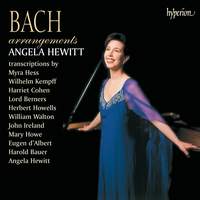Whose arrangement of Jesu, joy of man's desiring did pianists use before Myra Hess made hers?
Jesu, joy of man's desiring
Collapse
X
-
Looks like she might have started the trend.Originally posted by Rover_KE View PostWhose arrangement of Jesu, joy of man's desiring did pianists use before Myra Hess made hers?
-
-
It is. Having been forced to sing it at school probably helped put me off JS Bach for decades.Originally posted by mopsus View PostI think she may have a lot to answer for! I have sung it at countless weddings and it is a very tedious piece to sing. At least in the original cantata the two verses are not sung one after the other.
Comment
-
-
As an oboist who has played the obligato countless times in concerts, services and weddings, so far without passing out in the second half where breathing is all but impossible, I applaud Ms Hess for providing a less tortuous alternative.Originally posted by mopsus View PostI think she may have a lot to answer for! I have sung it at countless weddings and it is a very tedious piece to sing. At least in the original cantata the two verses are not sung one after the other.
Comment
-
-
I think some of its wedding popularity (which shows no signs of abating) is because it gently flows along with no gaps (sorry oboists) or dramatic changes of dynamic. It thus makes ideal background music for relatives chatting while the register is being signed.
When I was in the choir of St Ann's in Manchester, it was one of two anthems which were routinely suggested to couples who married there and wanted a choir, the other being Mozart's Ave Verum. We could sing either without rehearsal and were paid not very much for doing so; I estimated that hiring the entire choir of 20 or so cost barely 10% of the price of the cheapest wedding dresses on sale at that time.
Comment
-
-
Circular breathing could have solved that problem, although how many classical wind players can do that? - and is it even taught in colleges?Originally posted by Eine Alpensinfonie View Post
As an oboist who has played the obligato countless times in concerts, services and weddings, so far without passing out in the second half where breathing is all but impossible, I applaud Ms Hess for providing a less tortuous alternative.
Comment
-
-
Circular breathing is possible (just) on the oboe, but it does terrible things with your embouchure, resulting in very dodgy tuning.Originally posted by Serial_Apologist View Post
Circular breathing could have solved that problem, although how many classical wind players can do that? - and is it even taught in colleges?
Comment
-
-
Is that inevitable? Or the result of poor technique or mastery of the method? It isn't something I've been aware of during the choir concerts when we have oboes among the instrumentalists - and I'm usually standing on the front row, so close enough to the players to see when it is being deployed.Originally posted by Eine Alpensinfonie View Post
Circular breathing is possible (just) on the oboe, but it does terrible things with your embouchure, resulting in very dodgy tuning.
My daughter in effect taught herself how to do circular breathing, almost by instinct it seemed as she couldn't describe when or how she started doing it. It didn't affect her tuning. Mind you she taught herself to play the oboe full stop as the school teaching option was a clarinet player who didn't know about the oboe enough to help, and the instrument we managed to get for her had non-standard fingering. She turned out to have a real talent and it has always been a regret to me that she didn't continue to play, even just for pleasure. It was almost as if, once attention started to come from other quarters than school( offers of tuition, requests from local groups to play with them, encouragement to consider taking it seriously etc) that became a cue to just stop completely. I have a bitter sweet memory of her playing an oboe sonata at the final school concert of her final year at school, the pin-drop quiet as she began to play and the eruption of applause at the end.
Comment
-
-
Thanks to all for an interesting discussion—especially Pulcinella, who was the only one who really answered my question.
Comment
-
-
Riches indeed, half a crown when I did it.Originally posted by silvestrione View PostI loved singing it as a boy chorister, and we were well paid for weddings (was it 7 shillings? Riches!). Now I love the Myra Hess, especially as by Dinu Lipatti, but also Piers Lane on his disc of encores.
Comment
-
-
might be a tedious piece to sing but in the Hess arrangement it’s a very satisfying piece to play. For me it falls into the category of pieces that is much harder to play than it sounds - a real test of legato , pedalling and Cantabile. She , of course , plays it magnificently.Originally posted by mopsus View PostI think she may have a lot to answer for! I have sung it at countless weddings and it is a very tedious piece to sing. At least in the original cantata the two verses are not sung one after the other.
Comment
-
-
As does Angela Hewitt on her CD of interesting JSB arrangements (imho, of course):Originally posted by Ein Heldenleben View Post
might be a tedious piece to sing but in the Hess arrangement it’s a very satisfying piece to play. For me it falls into the category of pieces that is much harder to play than it sounds - a real test of legato , pedalling and Cantabile. She , of course , plays it magnificently.
Comment
-


Comment